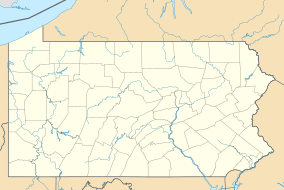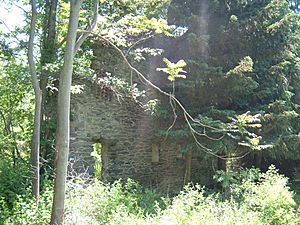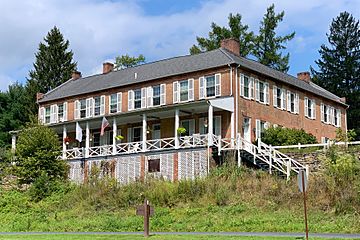Pine Grove Furnace State Park facts for kids
Quick facts for kids 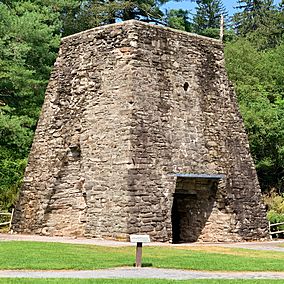
|
|
| Location | Mountain Creek valley South Mountain, Cumberland, Pennsylvania, United States |
|---|---|
| Area | 696 acres (282 ha) |
| Established | c. 1930 |
| Named for | Pine Grove Furnace |
| Governing body | Bureau of State Parks |
| Website | Pine Grove Furnace State Park |
Pine Grove Furnace State Park is a special park in Cumberland County, Pennsylvania. It's a protected area that includes two beautiful lakes: Laurel Lake and Fuller Lake. The park is a great place for many outdoor activities. It also protects the old Pine Grove Iron Works from 1764. Over the years, it was also home to Laurel Forge, Pine Grove Park, and a brick factory. You can find the park about 8 miles from Interstate 81 on Pennsylvania Route 233.
The Pennsylvania Department of Conservation and Natural Resources (DCNR) chose Pine Grove Furnace State Park as one of "25 Must-See Pennsylvania State Parks." The park is also home to the Appalachian Trail Museum.
Contents
Park History
The park is famous for its historic Pine Grove Iron Works. This area covers about 176 acres and has buildings from the old Pine Grove Furnace. This furnace started working in 1764 and stopped in 1895. Railways like the South Mountain RR and the Hunter's Run and Slate Belt Railroad helped connect these industrial areas.
Laurel Forge and Lake
Laurel Forge was a factory built in 1830 by Peter Ege. It made strong iron from the iron produced at Pine Grove Furnace. Laurel Forge Pond, which is now Laurel Lake, was created by building a dam. This dam helped power the forge's waterwheel using water from Mountain Creek.
By 1873, the Laurel Forge area had many buildings, including a boarding house and a train station. In 1884, "Laurel Station" became a stop for train trips. The Laurel Dam broke during floods in 1889 and 1919. Today, Laurel Lake is 25 acres and is a big part of the state park.
Fuller Brick and Slate Company
The Fuller Brick and Slate Company started its operations in 1892. They used clay found in the area's quarries to make bricks. Slate was also quarried nearby. They brought soapstone by wagon and clay by rail to their factory. The Pine Grove kiln could hold 12,000 bricks at a time. The brick factory was located south of the iron works and operated until about 1913.
How the Park Was Formed
The Pine Grove Division of the state's South Mountain Forest began in 1912. The South Mountain Mining & Iron Company sold 6,993 acres of land to the Pennsylvania Bureau of Forestry. In 1913, even more land was added, totaling 9,873 acres around Pine Grove and Laurel Forge.
By 1921, "Pine Grove" was one of Pennsylvania's seven "forest parks." Pine Grove Furnace State Park was officially created by 1931. The rest of the state forest became the Michaux State Forest.
Many of the park's buildings and facilities were built during the Great Depression. Young men from the Civilian Conservation Corps (CCC) Camp S-51-PA did this work. They built roads, bridges, planted trees, and cleaned streams. The old railroad tracks from 1912 have been removed. Laurel Lake and its dam were repaired between 2006 and 2007.
Fun Activities
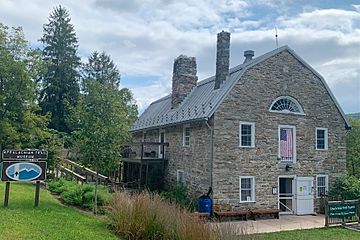
Fuller Lake is a 1.7-acre lake. It used to be a quarry for the Pine Grove Iron Works. You cannot use boats on Fuller Lake. Laurel Lake is a 25-acre lake. It was created to provide water power for Laurel Forge. On Laurel Lake, you can use electric-powered or non-powered boats. Gas-powered boats are not allowed. All boats must have a valid registration.
You can go archery hunting in most parts of the park during hunting season. Some smaller areas allow firearms hunting. Swimming at Fuller and Laurel Lakes is open from Memorial Day weekend until Labor Day weekend.
An old grist mill in the park is now the Appalachian Trail Museum. An old inn is now the park office. There are many picnic tables and two pavilions you can rent for gatherings.
Hiking Trails
The park has 1.4 miles of the famous Appalachian Trail. This trail follows the Cumberland County Biker/Hiker Trail. The midpoint marker for the Appalachian Trail is just east of the park. Hikers who complete the store's half-gallon ice cream challenge get a special wooden spoon! During winter, some trails are open for cross-country skiing and snowmobiling.
- Creek Trail is a 0.5-mile trail. It starts at the park amphitheater. It follows Mountain Creek. You might see vernal pools and white pine trees.
- Mountain Creek Trail is a 1.4-mile trail. It goes through wetlands and forests. You can follow Mountain Creek. Hikers might spot white-tail deer, heron, beavers, and waterfowl.
- Koppenhaver Trail is 1.0 mile long. It passes through a forest of hemlock and white pine trees.
- Swamp Trail is 0.25 miles long. As its name suggests, it goes through a swamp.
Camping and Places to Stay
The Charcoal Hearth Campground is south of the park's store. It has 71 sites for travel trailers and tents. Across the road, there's a wooded area for group tenting. The Paymasters Cabin has heating and can be rented. The Ironmaster's Mansion is a youth hostel. It's often used by Appalachian Trail hikers.
Nature and Wildlife
The park is located in the Mountain Creek valley. It also includes parts of Piney Mountain, Pole Steeple, and South Mountain. These areas are mostly covered in forests. You can find many common animals here. These include mammals, birds, and other creatures found in the northeastern US.
Laurel Lake attracts migratory waterfowl. You might see different kinds of butterflies in the summer. The lakes have fish like pickerel, trout, and perch. Mountain Creek is home to brook, brown, and rainbow trout.
Nearby Parks
Here are some other state parks close to Pine Grove Furnace State Park (within 30 miles):
- Big Spring State Forest Picnic Area (Perry County)
- Caledonia State Park (Adams and Franklin Counties)
- Codorus State Park (York County)
- Colonel Denning State Park (Cumberland County)
- Cunningham Falls State Park (Maryland)
- Fowlers Hollow State Park (Perry County)
- Gifford Pinchot State Park (York County)
- Kings Gap Environmental Education and Training Center (Cumberland County)
- Little Buffalo State Park (Perry County)
- Mont Alto State Park (Franklin County)


